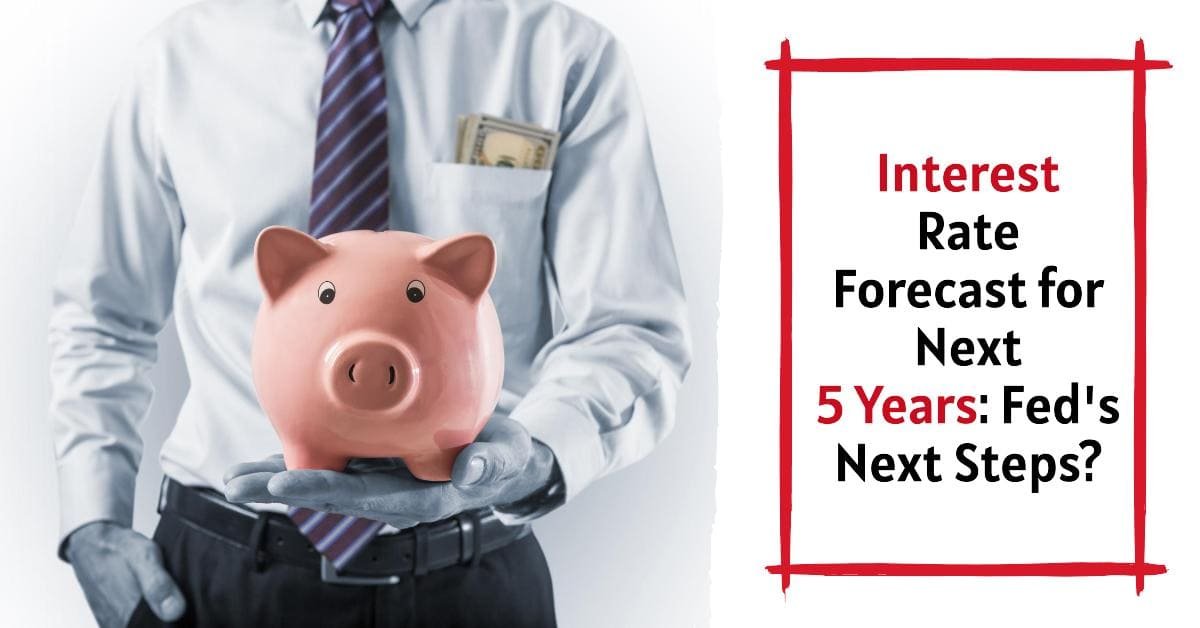The question of where interest rates are headed is a critical one for borrowers, savers, and investors alike. This article dives into expert predictions for the next five years, exploring what the Fed’s policy decisions might mean for your financial future.
The Federal Reserve acts as the captain of the interest rate ship. They steer the course primarily through the federal funds rate, which impacts the cost of borrowing for banks. These costs then ripple through the financial system, affecting everything from mortgages and car loans to credit card interest.
Compared to the historically low rates of recent years, we’re currently experiencing a change in the interest rate current. Inflation has become a top concern, prompting the Fed to raise rates in an effort to curb it. This has caused mortgage rates, for instance, to climb above 7%, a significant increase for many borrowers.
The current interest rate in the US is set by the Federal Reserve as a target range. As of July 2024, the target range for the federal funds rate is 5.25% to 5.50%. This means banks typically lend each other reserves overnight at a rate within this range. It indirectly affects borrowing costs for things like mortgages, car loans, and credit cards.
Let’s down the forecasts year by year, examining the expected trajectory of interest rates and the factors influencing this movement.
Interest Rate Predictions for the Next 5 Years
Forecast for 2024
2024 marks a pivotal year for interest rates. After raising rates throughout the first half in response to inflation concerns, the Federal Reserve is expected to take a more dovish approach as inflation shows signs of receding. Let’s dissect what the remainder of 2024 might hold for borrowers, savers, and the broader economy.
- A Gradual Shift: The Federal Open Market Committee (FOMC) forecasts at least one rate cut by year-end, with some members advocating for two. However, the exact timing and number of cuts remain uncertain. The Fed will likely adopt a wait-and-see approach, closely monitoring inflation data before implementing further adjustments. This measured approach suggests that significant reductions are unlikely before the latter half of 2024.
- Rates Above 5%: Despite the projected cuts, interest rates are expected to hover above 5% for the rest of 2024. This means borrowing costs for mortgages, car loans, and other debt instruments will likely remain elevated compared to recent years. For potential homebuyers, this could translate to higher monthly mortgage payments or a need for a larger down payment to qualify for a loan.
Impact on Different Financial Players:
- Borrowers: While a potential rate cut or two might offer some relief, borrowers should still expect a less forgiving lending environment compared to the pre-inflation era. Careful budgeting and exploring options with different lenders will be crucial for those considering major purchases like homes or cars.
- Savers: With interest rates on the rise, savers can finally expect to see some improvement in returns on savings accounts and certificates of deposit (CDs). However, the increase in rates might not fully offset inflation, so the purchasing power of saved money might see a slight decrease.
Overall Takeaway for 2024: We’re likely to witness a gradual shift in Fed policy, transitioning from tightening to a more neutral stance. However, significant reductions in interest rates are not anticipated this year. The remainder of 2024 will likely be a period of adjustment for both borrowers and savers as they navigate this evolving interest rate landscape.
Forecast for 2025: Anticipated Rate Cuts and Economic Balancing Act
2025 is shaping up to be a year of more pronounced interest rate action by the Fed. With inflation hopefully on a steadier downward trajectory, the central bank is expected to ramp up rate cuts in an effort to stimulate economic growth. Here’s what borrowers, savers, and the overall economy can expect:
- More Cuts on the Horizon: The Fed’s projections and market sentiment both point towards a more aggressive rate-cutting strategy in 2025. Forecasts suggest a total of four reductions throughout the year, potentially bringing the federal funds rate down to around 4.1% by year-end. This could translate to more favorable borrowing rates for mortgages, car loans, and other debt instruments.
- Balancing Act: While lower rates could boost borrowing and economic activity, the Fed needs to maintain a delicate balance. Cutting rates too quickly could reignite inflation concerns. The Fed will likely monitor economic data closely, adjusting the pace of rate reductions as needed.
Impact on Different Financial Players:
- Borrowers: This year could offer significant relief for borrowers, particularly those considering major purchases like homes or refinancing existing loans. As rates fall, borrowing costs should become more attractive, potentially increasing buying power. However, it’s crucial to remember that qualifying for loans may still require strong creditworthiness and a solid financial plan.
- Savers: While interest rates on savings accounts and CDs may continue to climb in 2025, the pace of increase might slow down compared to 2024. This is because the Fed’s primary goal will be to stimulate economic growth, not necessarily maximize returns for savers.
Overall Takeaway for 2025: 2025 is likely to see a more significant downward shift in interest rates. This could provide a boost to the economy and more favorable borrowing opportunities. However, the Fed will be walking a tightrope, aiming to achieve economic growth without reigniting inflation.
Forecast for 2026: Continued Adjustments and a New Normal
By 2026, the interest rate landscape is expected to settle into a more balanced state. The Fed will likely continue its rate-cutting strategy, but at a more measured pace compared to 2025. Let’s explore the potential implications for borrowers, savers, and the overall economic environment:
- Gradual Normalization: Forecasts suggest an additional four rate cuts in 2026, bringing the federal funds rate down to a range of 3.00% – 3.25% by year-end. This would represent a significant decrease from the current high rates but wouldn’t necessarily signal a return to pre-inflationary levels. The Fed will likely prioritize establishing a “new normal” interest rate environment that fosters economic stability and prevents future inflation spikes.
- Focus on Stability: The overarching goal in 2026 will likely be achieving a sustainable economic equilibrium. The Fed will strive to balance promoting economic growth with keeping inflation under control. This focus on stability might translate into a period of relatively consistent interest rates after the adjustments of the previous years.
Impact on Different Financial Players:
- Borrowers: Borrowing costs are likely to remain attractive compared to 2024, potentially opening up more opportunities for those looking to buy homes, cars, or refinance existing debt. However, lenders might still be cautious, and qualifying for loans could depend on individual creditworthiness.
- Savers: Interest rates on savings accounts and CDs might see some upward movement in 2026, but the increases might be more modest compared to the previous couple of years. With a focus on economic stability, the Fed might prioritize keeping rates from dipping too low, potentially limiting significant gains for savers.
Overall Takeaway for 2026: 2026 is expected to be a year of continued adjustments towards a new interest rate normal. Borrowers can expect a more favorable lending environment compared to the recent past. Savers might see some benefit, but significant gains might be limited. The overall focus will likely be on achieving long-term economic stability.
Forecast for 2027: A Look Towards Stability
By 2027, the interest rate landscape is anticipated to reach a state of relative stability, barring any unforeseen economic shocks. Let’s delve into what this potentially means for borrowers, savers, and the broader economic climate:
- Settling into a New Normal: After several years of adjustments, interest rates are expected to reach a new equilibrium in 2027. Forecasts suggest the federal funds rate remaining around 2.9%, a level the Fed deems appropriate for fostering economic growth without reigniting inflation. This relative stability could bring a sense of predictability to financial planning for both borrowers and savers.
- Focus on Long-Term Growth: With inflation hopefully under control and interest rates established at a sustainable level, the Fed’s focus might shift towards promoting long-term economic growth. This could involve measures beyond just interest rate adjustments, potentially including policies that encourage investment and job creation.
Impact on Different Financial Players:
- Borrowers: Borrowing costs in 2027 are likely to remain at a level that supports economic activity. While not necessarily as low as pre-inflationary periods, rates should be conducive to borrowing for mortgages, car loans, and other needs, assuming strong creditworthiness.
- Savers: While some interest rate growth on savings accounts and CDs might still occur, significant gains might be less likely. The Fed’s priority on long-term economic growth could translate to a focus on keeping rates from dipping too low, potentially limiting substantial returns for savers. However, the established interest rate environment could offer more predictability for those planning for future financial goals.
Overall Takeaway for 2027 and Beyond: The period from 2027 onwards is expected to be one of relative stability in the interest rate landscape. Borrowers and savers can expect a more predictable environment for financial planning. The focus will likely shift towards fostering long-term economic growth through a combination of monetary and potentially non-monetary policies. It’s important to remember that these are forecasts, and unforeseen events could always necessitate adjustments to the Fed’s approach.
IMF Interest Rate Forecast for the Federal Reserve
Here’s the projected path of interest rates based on the IMF’s latest data:
| Quarter | Interest Rate |
|---|---|
| Q1 2024 | 5.4% |
| Q2 2024 | 5.3% |
| Q3 2024 | 5.0% |
| Q4 2024 | 4.7% |
| Q1 2025 | 4.5% |
| Q2 2025 | 4.3% |
| Q3 2025 | 4.1% |
| Q4 2025 | 3.9% |
| Q1 2026 | 3.7% |
| Q2 2026 | 3.5% |
| Q3 2026 | 3.3% |
| Q4 2026 | 3.1% |
| Q1 2027 | 2.9% |
| Q2 2027 | 2.9% |
| Q3 2027 | 2.9% |
| Q4 2027 | 2.9% |
| Q1 2028 | 2.9% |
| Q2 2028 | 2.9% |
| Q3 2028 | 2.9% |
| Q4 2028 | 2.9% |
Summary:
The next five years are expected to be a period of significant change in the interest rate landscape. After a period of historically low rates, the Fed has begun raising rates to combat inflation. However, with inflation showing signs of easing, a shift towards rate cuts is anticipated.
Here’s a quick recap of the projected trajectory:
- 2024: A year of transition with potentially one or two rate cuts by the Fed. Interest rates are likely to remain above 5% for the remainder of the year.
- 2025: More pronounced rate cuts are expected, potentially bringing the federal funds rate down to around 4.1% by year-end. This could provide a boost to the economy and more favorable borrowing opportunities.
- 2026: Continued adjustments with an additional four rate cuts anticipated, settling the federal funds rate around 3.00% – 3.25% by year-end. The focus will likely be on achieving a new normal for interest rates that fosters stability.
- 2027 and Beyond: The interest rate landscape is expected to reach a state of relative stability, with the federal funds rate hovering around 2.9%. Borrowers and savers can expect a more predictable environment for financial planning. The Fed’s focus might shift towards promoting long-term economic growth.
Remember, these are forecasts, and unforeseen economic events could always necessitate adjustments to the Fed’s approach. Staying informed about the latest economic data and policy decisions can empower you to make informed financial decisions throughout this period of change.
ALSO READ:





